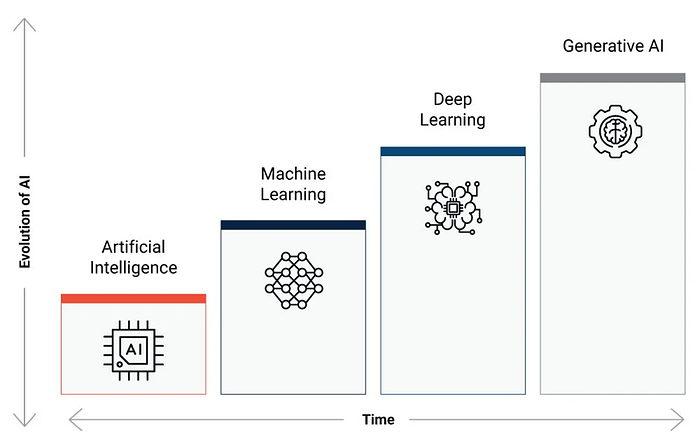AI, ML, DL and GenAI
AI: Artificial Intelligence, ML: Machine Learning, DL: Deep Learning, GenAI: Generative AI

Artificial Intelligence
AI describes the capability of the machine to learn and solve problems just like humans. In other words, AI refers to the replication of humans, how it thinks, works and functions.
AI can be seen as a program that instructs the machine to function in a certain way according to the situation. So, we can call a bunch of if-else statements, AI.
For instance, self-driving car moving on the road. A small algorithmic rule for such a car can be:
if distance_from_in_front <100m:
stop();
else:
keep_moving();There are two ways of incorporating intelligence in artificial things i.e., to achieve artificial intelligence. One is through machine learning and another is through deep learning. That means DL and ML are ways of achieving AI.

AI encompasses a wide range of techniques beyond just ML and DL, including symbolic reasoning, optimization, and uncertainty handling methods. Each of these techniques has its own strengths and applications, and the choice of algorithm depends on the specific problem and requirements.
Artificial Intelligence Examples
- Virtual Assistants: AI-powered assistants like Siri, Google Assistant, and Alexa can understand natural language and perform tasks, such as setting reminders, answering queries, and controlling smart home devices.
- Recommendation Systems: AI algorithms analyze user preferences and behavior to provide personalized recommendations for products, movies, music, and more.
- Chatbots: AI-driven chatbots engage in natural language conversations with users, assisting with customer support, answering questions, and providing information.
- Autonomous Vehicles: AI enables self-driving cars to navigate and make decisions based on real-time data from sensors and cameras.
- Image and Video Analysis: AI can analyze and interpret visual content, including object detection, facial recognition, and content moderation.
- Language Translation: AI-powered translation tools automatically convert text between different languages.
- Fraud Detection: AI systems can detect fraudulent activities and transactions in real-time, helping prevent financial losses.
- Healthcare Diagnosis: AI assists in diagnosing medical conditions by analyzing medical images and data, aiding in early detection and treatment.
- Smart Personalization: AI enables personalized experiences in various applications, such as content recommendations, user interfaces, and targeted marketing.
- Email Filtering: AI algorithms categorize emails as spam or important based on content and user behavior.
- Gaming: AI agents can play games against human players, offering challenging opponents with advanced strategies.
- Speech Recognition: AI-powered speech recognition systems convert spoken language into text, used in voice assistants and transcription services.
- Robotics: AI is used in robotics to enable machines to perform complex tasks, interact with the environment, and learn from experience.
- Music and Art Generation: AI can compose music, create art, and generate creative content using deep learning algorithms.
- Security and Surveillance: AI enhances security by analyzing surveillance data, detecting anomalies, and identifying potential threats.
Machine Learning
ML comprises algorithms for accomplishing different types of tasks such as classification, regression, or clustering. The accuracy of algorithms increases with an increase in data.
“Technique to learn from data through training and then apply learning to make an informed decision”

Analyzing and learning from data comes under the training part of the machine learning model. During the training of the model, the objective is to minimize the loss between actual and predicted value. For example, in the case of recommending items to a user, the objective is to minimize the difference between the predicted rating of an item by the model and the actual rating given by the user.
“Difference between the predicted and actual value is computed using loss-function or objective function. Therefore, defining the objective/loss function is the gist of ML model.”
In today’s era, ML has shown great impact on every industry ranging from weather forecasting, Netflix recommendations, stock prediction, to malware detection. ML though effective is an old field that has been in use since the 1980s and surrounds algorithms from then. Below is a small snippet of the ML model.
from sklearn.linear_model import LinearRegression predictor = LinearRegression(n_jobs=-1) predictor.fit(X=TRAIN_INPUT, y=TRAIN_OUTPUT) Machine Learning Examples
- Image Recognition: Identifying objects, people, or patterns within images. Used in facial recognition, object detection, and self-driving cars.
- Natural Language Processing (NLP): Understanding and processing human language. Used in chatbots, sentiment analysis, and language translation.
- Speech Recognition: Converting spoken language into text. Used in virtual assistants, voice-controlled systems, and transcription services.
- Recommendation Systems: Recommending products, movies, or content based on user preferences. Used in e-commerce, streaming platforms, and personalized marketing.
- Anomaly Detection: Identifying unusual patterns or outliers in data. Used in fraud detection, fault monitoring, and cybersecurity.
- Predictive Maintenance: Predicting when equipment or machinery may fail to enable timely maintenance. Used in manufacturing and industrial settings.
- Credit Scoring: Assessing creditworthiness of individuals or businesses. Used in financial institutions for loan approvals.
- Healthcare Diagnostics: Assisting in disease diagnosis and medical image analysis. Used in medical imaging, pathology, and radiology.
- Autonomous Vehicles: Enabling self-driving cars to navigate and make decisions based on real-time data.
- Language Generation: Generating text, such as auto-complete suggestions or chatbot responses.
- Fraud Detection: Identifying fraudulent transactions in banking and online transactions.
- Virtual Assistants: AI-driven applications that respond to voice commands and perform tasks like scheduling and reminders.
- Stock Market Prediction: Forecasting stock prices and market trends based on historical data.
- Customer Segmentation: Dividing customers into groups based on their behaviors and preferences for targeted marketing.
- Personalized News Feeds: Providing users with tailored news and content based on their interests and reading habits.
Deep Learning
Deep learning is based on an artificial neural network which is nothing but a mimic of the working of the human brain.
As ML models, the DL model requires a large amount of data to learn and make an informed decision and is therefore also considered a subset of ML. This is one of the reasons for the misconception that ML and DL are the same. However, the DL model is based on artificial neural networks which have the capability of solving tasks that ML is unable to solve.

Some of the systems driven by DL models include Alexa, Siri, Google Voice Assistant, Google Translation, Self-driving cars, etc.
Deep Learning Examples
- Image Classification: Classifying objects, scenes, or animals in images. Used in photo organization, automated tagging, and medical image analysis.
- Natural Language Processing (NLP) Tasks: Performing advanced NLP tasks, such as language translation, sentiment analysis, and text generation.
- Speech Recognition: Converting spoken language into text with high accuracy. Used in voice assistants, transcription services, and speech-to-text applications.
- Object Detection: Identifying and locating multiple objects within an image. Used in autonomous vehicles, surveillance systems, and video analysis.
- Facial Recognition: Identifying and verifying individuals based on facial features. Used in security systems, unlocking devices, and personalized experiences.
- Generative Adversarial Networks (GANs): Generating new, realistic data by pitting two neural networks against each other. Used in generating synthetic images, videos, and art.
- Recommendation Systems: Creating personalized recommendations for users based on their preferences and behavior.
- Semantic Segmentation: Assigning a semantic label to each pixel in an image, used in advanced image understanding tasks.
- Style Transfer: Transferring the style of one image to another, creating artistic effects.
- Autonomous Vehicles: Enabling self-driving cars to navigate and make decisions based on real-time data using DL models like Convolutional Neural Networks (CNNs).
- Drug Discovery: Assisting in drug discovery and design by predicting molecular properties and interactions.
- Medical Diagnosis: Assisting doctors in diagnosing medical conditions using DL models trained on medical images and data.
- Game AI: Training DL models to play games and achieve superhuman performance, such as DeepMind’s AlphaGo.
- Chatbots: Creating conversational agents that can interact with users and answer queries.
- Music Generation: Generating new music compositions using DL models.
Deep learning is built to work on a large dataset that needs to be constantly annotated. But this process can be time-consuming and expensive, especially if done manually. DL models also lack interpretability, making it difficult to tweak the model or understand the internal architecture of the model. Furthermore, adversarial attacks can exploit vulnerabilities in deep learning models, causing them to make incorrect predictions or behave unexpectedly, raising concerns about their robustness and security in real-world applications.
These challenges have led to the emergence of Generative AI as a specific area within DL.
Generative AI (GenAI)
Generative AI is a branch of artificial intelligence and a subset of Deep Learning, focuses on creating models capable of generating new content that resemble existing data. These models aim to generate content that is indistinguishable from what might be created by humans. Generative Adversarial Networks (GANs) are popular examples of generative AI models that use deep neural networks to generate realistic content such as images, text, or even music.

Generative AI Examples
- Image Generation: Generative AI can learn from large sets of images and generate new unique images based on trained data. This tool can generate images with creativity based on prompts like human intelligence.
- Video Synthesis: Generative models can create new content by learning from existing videos. This can include tasks such as video prediction, where the model generates future frames from a sequence of input frames. It can also perform video synthesis by creating entirely new videos. Video synthesis has entertainment, special effects, and video game development applications.
- Social Media Content Generation: Generative AI can be leveraged to automate content generation for social media platforms, enabling the creation of engaging and personalized posts, captions, and visuals. By training generative models on vast amounts of social media data, such as images and text, they can generate relevant and creative content tailored to specific user preferences and trends.
Summary
GenAI ⊂ DL ⊂ ML ⊂ AI

